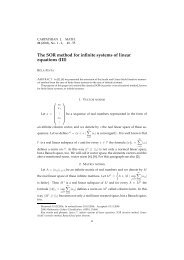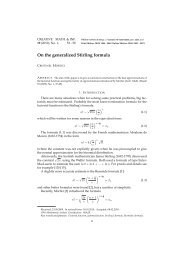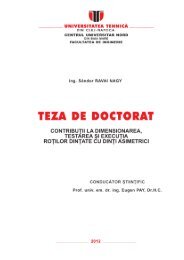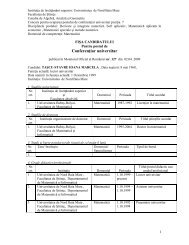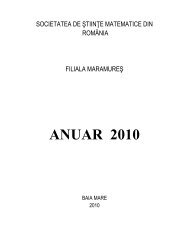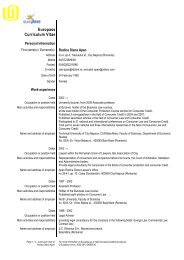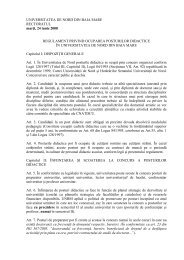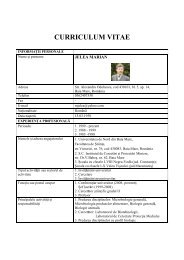Vol 3 (1) 2011 - UBM :: Departamentul de Chimie-Biologie
Vol 3 (1) 2011 - UBM :: Departamentul de Chimie-Biologie
Vol 3 (1) 2011 - UBM :: Departamentul de Chimie-Biologie
You also want an ePaper? Increase the reach of your titles
YUMPU automatically turns print PDFs into web optimized ePapers that Google loves.
Carpathian Journal of Food Science and Technology <strong>2011</strong>, 3(1), 72-74<br />
3. Results and discussion<br />
The mean values of fat content of different samples of unbran<strong>de</strong>d butter sold in<br />
Lahore are presented in Table 1. The results showed that fat content of all the five samples<br />
(A, B, C, D & E) were less than prescribed standards of Pakistan Standard and Quality<br />
Control Authority (PSQCA) 84%. Fat content of all the samples varied significantly among<br />
each other, the lowest value with respect to fat was 72.5% was recor<strong>de</strong>d in sample A.<br />
Moisture content of A, B and D was more than allowable limits of PSQCA (16% max.). The<br />
highest moisture contents 25.11% were recor<strong>de</strong>d in sample A followed by 23.73% in D. The<br />
reason for higher moisture content in all the samples was probably be due to the lack of<br />
appropriate equipment for cream churning and butter working which may have contributed in<br />
this phenomenon. This might also be due to the urge of making more money. Sample D was<br />
criticized for having bad smell this was obvious from free fatty acids content (0.25%). The<br />
reason for high free fatty acids was due to the extremely poor handling of cream and the<br />
another reason for higher free fatty could be due to the use of foots of palm oil which is<br />
evi<strong>de</strong>nt from the iodine value of sample D 38.50 as compared to other samples. Palm oil and<br />
other vegetable oils like canola oil is commonly used as adulterant in butter.<br />
Table 1. Physicochemical composition of butter samples<br />
Sample FAT M FFM FFA PV AV TV MP IV CF<br />
EC<br />
A 72.56 e 25.11 a 2.33 a 0.14 5.60 19.90 25.50 d 29.10 d 46.77 -ve -ve<br />
+2.89 +1.61 +0.11 +0.06 d +1.98 d +3.22 d +3.66 +3.82 +5.13 a<br />
B 78.80 c 19.55 c 1.65 c 0.11 4.25 17.55 21.80 33.80 36.45 +ve +ve<br />
+3.25 +1.23 +0.08 +0.03 e +1.33 e +2.56 e +3.11 e +3.33 c +4.46 d<br />
C 81.60 b 16.37 d 2.03 b 0.16 c 6.32 22.47c 28.79 34.60 35.62 +ve +ve<br />
+3.67 +1.09 +0.12 +0.07 +1.70 c +3.86 +3.77 c +3.92 c +4.10 d<br />
D 75.20 d 23.73 b 1.47 d 0.25 a 10.69 30.67 b 41.36 38.50 39.84 -ve -ve<br />
+3.11 +1.49 +0.19 +0.06 +1.99 b +3.99 +4.26 b +3.99 b +4.76 b<br />
E 82.50 a 15.22 e 2.28 a 0.19 b 14.80 39.77 54.57 40.50 38.11c +ve +ve<br />
+4.59 +0.98 +0.14 +0.02 +2.11 a +4.19 a +5.23 a +4.18 a +4.22<br />
Means of duplicate experiment; means with same superscript letter in same column are statistically non<br />
significant by Tuckey’s T-Test at 0.05 level of significance.<br />
M: Moisture Content FFM: Fat Free Matter FFA: Free Fatty Acids PV: Peroxi<strong>de</strong> Value<br />
AV: Para Anisidine Value TV: Totox Value MP: Melting Point IV: Iodine Value<br />
CF: Coliforms<br />
EC: E.Coli<br />
73



